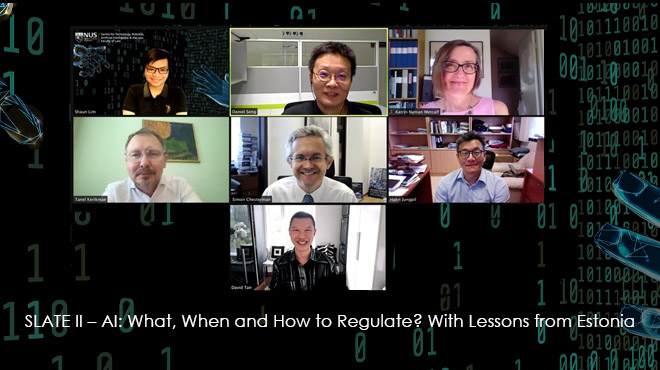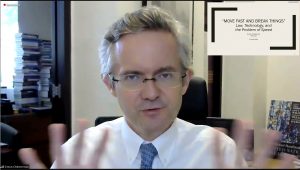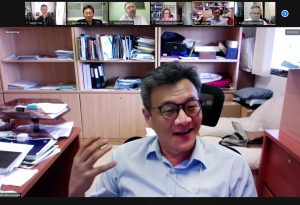Media - News
- Media
- SLATE II – AI: What, When and How to Regulate? With Lessons from Estonia
SLATE II – AI: What, When and How to Regulate? With Lessons from Estonia

On 9 June 2021, the Centre for Technology, Robotics, AI & the Law (TRAIL) held its second session of the Seminars on Law and Technology series (SLATE II), entitled “AI: What, When and How to Regulate? With Lessons from Estonia”. Held via Zoom due to social distancing measures, with the Director of TRAIL, Associate Professor Daniel Seng, as the moderator, over 60 participants from a range of legal and technical sectors attended the seminar.

Dean Professor Simon Chesterman speaking about the speed of modern technological advances
Professor Simon Chesterman, Dean of NUS Law, kicked off the seminar with a presentation that explored the difficulties for regulation posed by the sheer speed of modern technological advances. He offered as examples the use of algorithmic trading and the proliferation of deepfakes. Permitting them to remain unchecked created the risk of runaway automated responses with little opportunity for human intervention, but premature regulation risked stifling the benefits of these advances and inviting regulatory arbitrage.
This was followed by Professors Katrin Nyman Metcalf and Tanel Kerikmäe from the Tallinn University of Technology, Estonia. Drawing on their experiences in e-governance, they pointed out that while specialised legislation might initially appear attractive, that option suffered from the risk of obsolescence and lack of ongoing oversight and should be used with caution. However, an omnibus AI regulation was also unlikely to work, and in developing regulations, regulators had to be aware of the global, borderless nature of technology and the need for technology neutral laws that would create ecosystems of trust, such as privacy or data protection and national security. To encourage further trust in AI systems, Estonia enacted legislation affirming that the State remains responsible for all the consequences of e-government services, including those provided through AI. It also considered but did not proceed with a public insurance fund for addressing AI liability claims.

Professor Katrin Nyman Metcalf explaining the role of law in relation to developments in artificial intelligence

Professor Tanel Kerikmäe going through the steps of rulemaking
The authors also commented on one another’s papers. They were joined by Associate Professor Jungpil Hahn, Head of the Department of Information Systems and Analytics at the NUS School of Computing, who opined that the developers’ mindset, their appreciation of the risks and consequences, and appreciation of algorithmic fairness and bias are additional considerations germane to regulation. He observed that for many of these new technologies, there was no good way to balance the harms against the benefits, especially as many of the harms were unknown, unquantifiable, or unpredictable. There was also a lack of sufficient collective and open oversight over key technologies and a lack of consensus about the correct ethical approaches to technology. In their absence, it would be difficult to institute regulations that were effective yet still left enough room for further technological development.

Associate Professor Jungpil Hahn commenting on the papers
A lively discussion then followed with questions posed by many of the contributors that raised a broad range of technical and legal issues. These included the relevance of horizontal regulations versus specific regulations, the use of a collective development model to improve oversight over key AI technologies and the use of private or public insurance to mitigate the risks of harms arising from the use of AI.
SLATE II is based on two articles published in the 2021 Singapore Academy of Law Journal Special Issue on Law and Technology: Simon Chesterman, “‘Move Fast and Break Things’: Law, Technology, and the Problem of Speed”; Katrin Nyman Metcalf & Tanel Kerikmäe, “Machines Are Taking Over – Are We Ready?: Law and Artificial Intelligence”. The articles can be accessed here. (https://law.nus.edu.sg/trail/projects/saclj-special-issue-slate/)

